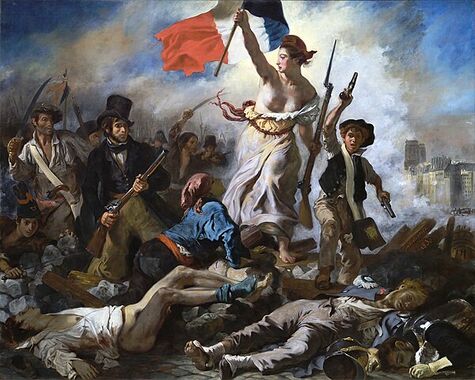Age of Revolution: Difference between revisions
Harrystein (talk | contribs) (Created page with "The '''Age of Revolution''' is the name coined by Marxist historian Eric Hobsbawm in his 1962 work of the same name to refer to the period between 1789 and 1848 when huge revolutionary waves moved throughout Europe and the Americas, resulting in the development of bourgeois republican nation-states, modern liberal political thought, and the firs...") |
RedParabola (talk | contribs) m (Image) |
||
| Line 1: | Line 1: | ||
[[File:La Liberté guidant le peuple.jpg|thumb|475x475px|Depiction of the [[July Revolution|1830 revolution in France]]. ]] | |||
The '''Age of Revolution''' is the name coined by [[Marxist historiography|Marxist historian]] [[Eric Hobsbawm]] in his [[The Age of Revolution: Europe 1789–1848|1962 work of the same name]] to refer to the period between 1789 and 1848 when huge [[revolution]]ary waves moved throughout Europe and the Americas, resulting in the development of [[bourgeois]] [[bourgeois democracy|republican]] [[nation-state]]s, modern [[liberalism|liberal]] political thought, and the first attempts at [[proletarian revolution]]. | The '''Age of Revolution''' is the name coined by [[Marxist historiography|Marxist historian]] [[Eric Hobsbawm]] in his [[The Age of Revolution: Europe 1789–1848|1962 work of the same name]] to refer to the period between 1789 and 1848 when huge [[revolution]]ary waves moved throughout Europe and the Americas, resulting in the development of [[bourgeois]] [[bourgeois democracy|republican]] [[nation-state]]s, modern [[liberalism|liberal]] political thought, and the first attempts at [[proletarian revolution]]. | ||
| Line 7: | Line 8: | ||
== References == | == References == | ||
{{reflist}}[[category:historical materialism]][[category:18th century]][[category:19th century]] | {{reflist}} | ||
[[Category:Revolution]] | |||
[[category:historical materialism]][[category:18th century]][[category:19th century]] | |||
Revision as of 23:34, 15 June 2024

The Age of Revolution is the name coined by Marxist historian Eric Hobsbawm in his 1962 work of the same name to refer to the period between 1789 and 1848 when huge revolutionary waves moved throughout Europe and the Americas, resulting in the development of bourgeois republican nation-states, modern liberal political thought, and the first attempts at proletarian revolution.
Influenced by the new ideas of the Enlightenment, the American Revolution (1765–1783) is usually considered the starting point of the Age of Revolution. It in turn inspired the French Revolution of 1789, which rapidly spread to the rest of Europe through its wars. In 1799, Napoleon took power in France and continued the French Revolutionary Wars by conquering most of continental Europe. Although Napoleon imposed on his conquests several progressive liberal concepts such as equality before the law, or a civil code, his rigorous military occupation triggered national rebellions, notably in Spain and Germany. After Napoleon's defeat, Austria, Prussia, and Russia created the reactionary "Holy Alliance" at the Congress of Vienna in 1814–15 in an attempt to prevent future revolutions, along with restoring the monarchies that had been overthrown. Nevertheless, Spain, already regressing behind the developed bourgeois states, was considerably weakened by the Napoleonic Wars and could not control its American colonies, almost all of which proclaimed their independence between 1810 and 1820. Revolution then spread back to southern Europe in 1820, with uprisings in Portugal, Spain, Italy, and Greece. Continental Europe was shaken by two similar revolutionary waves in 1830 and 1848, in which the growing proletariat played a significant role in opposition to bourgeois and monarchist forces. The democratic demands of the revolutionaries often merged with independence or national unification movements, such as in Italy, Germany, Poland, Hungary, etc. The violent repressions of the 1848 revolutions marked the end of the era of major revolutions and the beginning of what Hobsbawm called the Age of Capital.